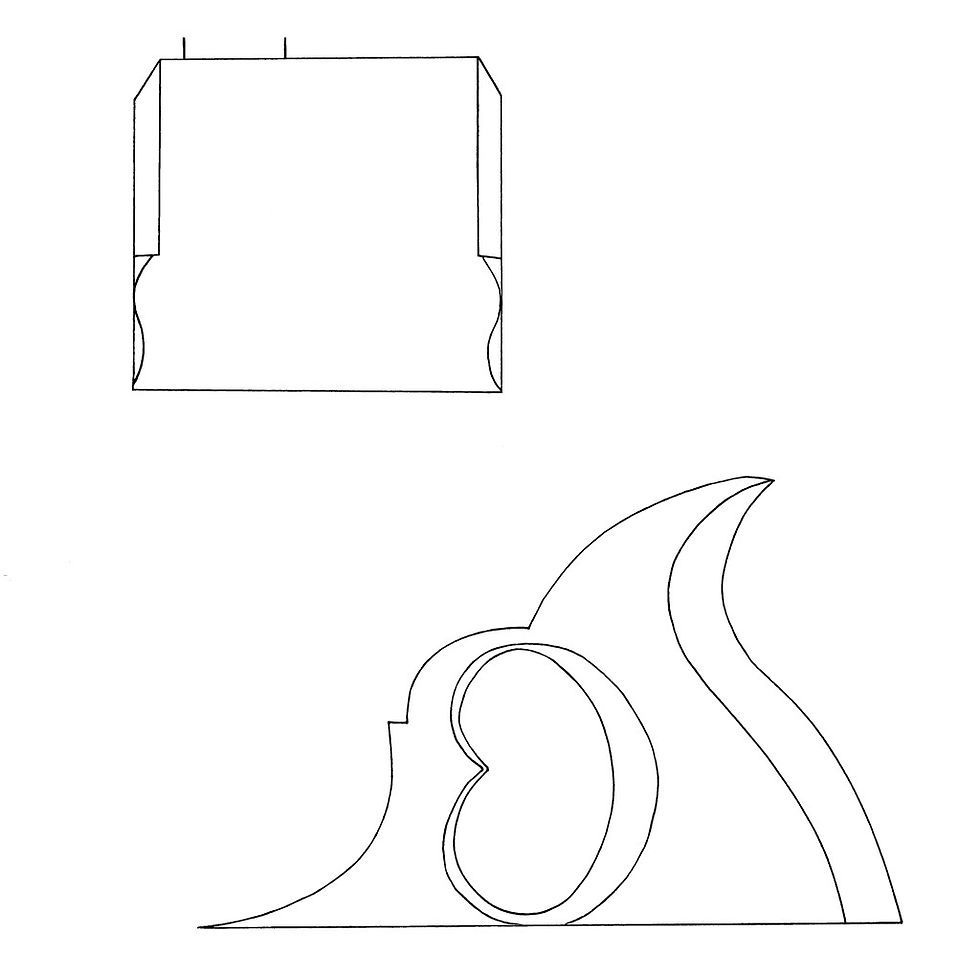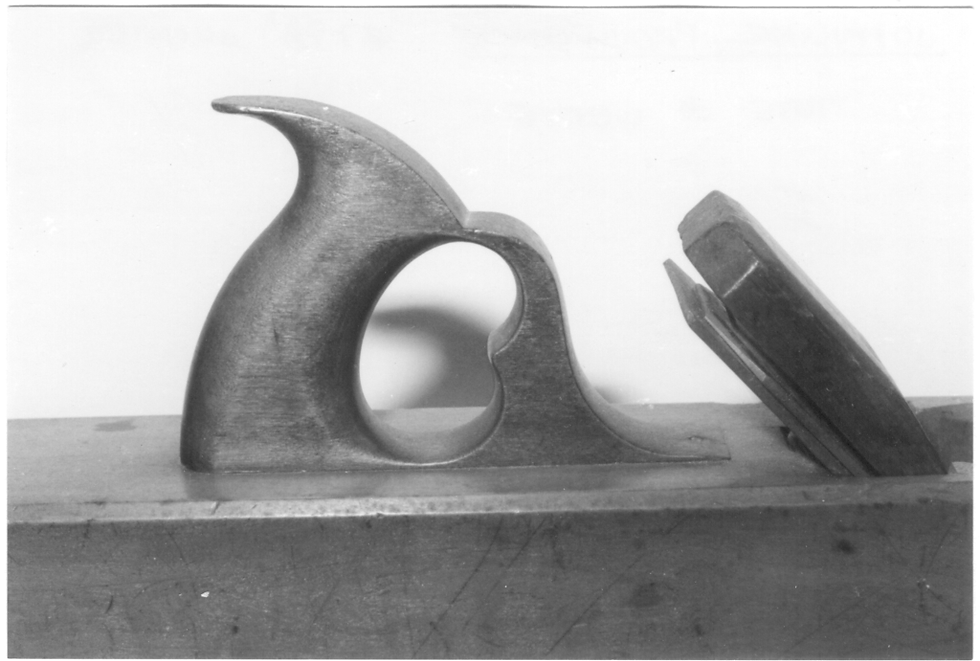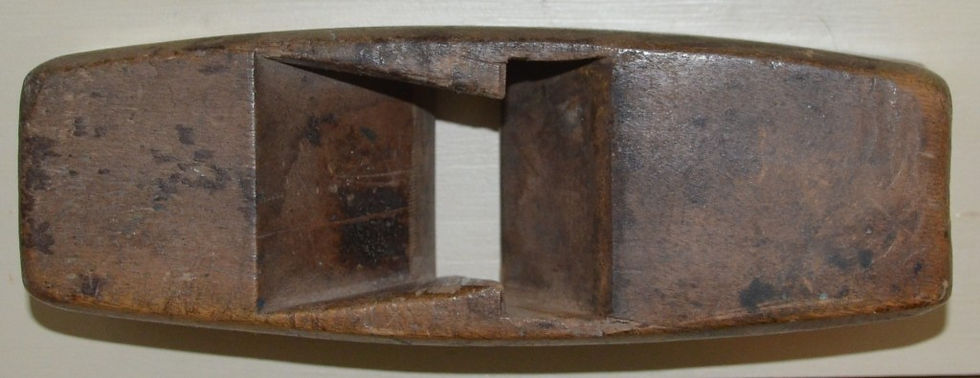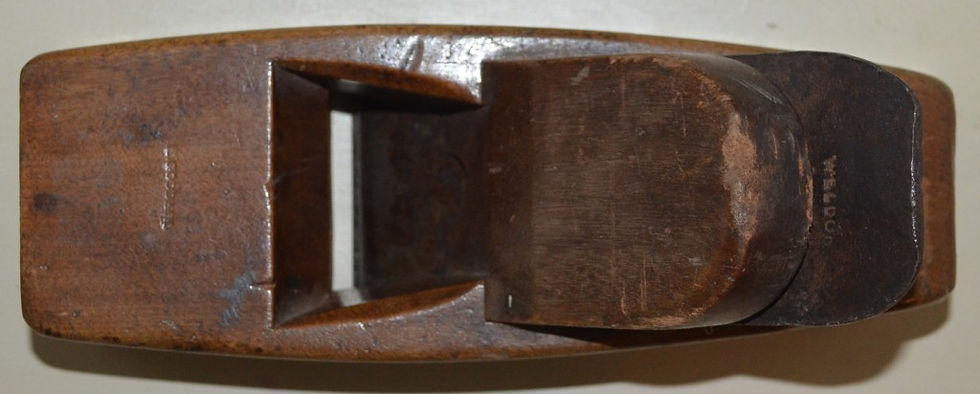Joseph Fuller Bench Planes
- marcsitkin
- Jun 16, 2015
- 10 min read
Updated: Oct 26, 2023
Joseph Fuller (b. 1746 - d. 1822) was one of the most important American planemakers during the later 1700’s through the early 1800’s. He was making and selling planes as early as 1773 in Providence, RI, and died there in 1822. (1) He seems to have been quite successful in his trade and produced products that were quite refined in their details and lines. Researchers have outlined both Joseph’s life and his planes in articles over the last 30 years (2), (3), (4), (5), (6). They have developed a chronology of his marks and a chronology of his plane details based on Joseph’s molding planes. Presented here is a brief look at his bench planes, which is very much built upon and tied to this earlier body of work.
First, let’s review the basic periods of Mr. Fuller’s planemaking career as defined by his molding planes. This is a very useful place to start as the bench planes will follow this same general outline and share many of the same traits as the molding planes. In chapter II of Wooden Planes in 19th Century America, Vol. II, by Kenneth Roberts, Edward Ingraham has set out the basic chronology of Joseph’s planes including both descriptions and photographs. He states: “Fuller’s earliest planes, bearing simply the large embossed stamp ‘JO FULLER’, surrounded by a zig-zag border, were 10 inches long, constructed from birch, and supported a step, molded with a cove. The wedge was slightly relieved and shallow decorative notches were applied to the toe and heel.” (7) (AWP IV three dot stamps A and B) The B imprint includes the location stamp ‘PROVIDANCE’. (8) These planes have 5/16” wide flat chamfers that are mostly on the sides.
Edward’s description continues: “The second period of Fuller’s planes demonstrated several small changes in design; the relief of the wedge was more pronounced and the heel was rounded slightly more than previously and he adopted a new and smaller stamp which also noted his location, ‘JO FULLER / IN / PROVIDENCE’”. (9) (AWP IV stamps C and C1) These planes have slightly narrower flat chamfers which average about ¼” in width that are still mostly on the sides.
Joseph then modifies the C / C1 stamps and omits the “IN” portion of his mark yielding the D /D1 imprints. (10) Edward describes this as Joseph’s third period. “Among the changes observed in Fuller’s planes include a more sharply defined relieved wedge, deeper decorative notching on the heel and slightly narrower chamfering (3/16 – ¼ of an inch).”(11) Mike Humphrey, in his publication, The Catalog of American Wooden Planes, dates planes with the D /D1 marks and still flat chamfers to approximately the first half of the 1790’s. (12) Joseph Fuller then adopts rounded top chamfers with flat chamfers on the toe and heel, still with the flutes below and 10 inches in length. Mike places an approximate date for these planes to the later part of the 1790’s. (13)
Finally, about 1800-1810, Joseph begins to shorten the molding plane lengths to the standard 9 ½ “and to incorporate standard 19th century style details. These details include the use of beech, omission of the end flutes and an unrelieved wedge with a swept back finial. (14) His last smaller marks, E and E1, are used on these later fourth period planes. (15)
Let’s now look at the bench planes. Presented are descriptions, drawings and photographs of five Fuller bench planes; three jointers and two smoothers. These five planes fall within Joseph’s first three periods as outlined above, as defined by the imprints and chamfer details.
The Jointer Planes
In 1999, I was privileged to add a Jo Fuller bench plane to my collection. (Here, I must admit to an affinity for both Fuller planes and 18th century bench planes!) This jointer falls within the later third period of Joseph’s work. The plane is made of birch and has small rounded chamfers along the top of the body with flat chamfers on the ends. The end chamfers terminate with a slight backward tip followed by a small flat, that gently rounds downward. Molding planes of this same period show the same exact chamfer details, except this jointer does not have flutes below the chamfer stops. The smallish offset closed tote is of an early but somewhat standard 19th century form. The heel of the tote is relieved to fit into a square mortise. The D1 imprint is found centered upside-down on the toe. The wedge has a rounded top and is relieved with 3/16“flat chamfering. The single iron is also rounded and is marked Newbould. (See figure 1 and photograph 2 (right).)
(Note that in each drawing, all elements are presented in a common scale. Each drawing can be re-scaled by referencing the maximum body width.)

Figure 1: Later Jo Fuller D1 jointer #1 tote and toe
Jointer #1 Specifications:
Imprint: JO , FULLER / PROVIDENCE, (AWP IV imprint D1)
Length: 27 7/8”.
Width: 3 1/8”.
Wood: Birch.
Chamfers: Small rounded on the top, flat on the ends.
Chamfer stops: Slightly tipped back then small flat tapers which are slightly rounded. No flutes below the chamfer stops.
Tote details: Square mortise with undercut tote heel. Offset to the right.
Wedge: Round topped with 3/16” flat chamfers.
Mouth details: Long tapered eye chamfers about 1/8”+ wide.
Iron: Single, round topped. Marked 'Newbould' with incuse block letters.
Other: Diamond shaped metal strike knob.
In the Fall of 2000, I was able to look at two great Rhode Island tool collections. Within one collection, there was an early Jo Fuller jointer. It has a beautiful offset closed tote that is quite unlike the above later D1 period plane. I did not expect to see Jo Fuller use this style. It is similar to a R DYER jointer presented in Sign of the Jointer.(16) The plane has the three dot A mark ‘JO : FULLER’ with ‘IN / PROVIDENCE’ stamped below. This mark was mentioned in AWP IV but not illustrated. The tote is significantly offset to the right and the heel is undercut to fit a squared mortise. The eye chamfers are flat and straight similar to those found on F Nicholson, Ce Chelor and E Briggs bench planes. In addition, the opening of the escapement in the body is rather long when compared to the later D1 jointers and the front bevel of the escapement is also at a shallower angle than the D1 jointers. These two features are very reminiscent of the escapement opening design found in a F Nicholson smoothing plane. (17) In photograph 2, the escapement elements of this early three dot jointer and the later D1 jointer #1 can be readily compared along with the amount of the tote offset. The body chamfers are of the classic first period style, 5/16”+, followed by bold flutes on the ends. The wedge is nearly identical to the above D1 jointer. (See figure 2 and photographs 1 and 2 (left).)

Figure 2: Jo Fuller three dot jointer #2 tote and toe

Photo 1: Jo Fuller 3 dot jointer #2 tote and wedge

Photo 2: Comparative escapements three dot (left) and later D1 (right) Jo Fuller jointers
Jointer #2 Specifications:
1. Imprint: Three dot JO FULLER (AWP IV imprint A) above / IN / PROVIDENCE.
2. Length: 29 1/16”.
Width: 3 ”.
Wood: Birch.
Chamfers: 5/16”+ wide and flat, mostly on sides.
Chamfer stops: Slightly tipped back then a classic flute.
Tote details: Square mortise with undercut tote heel. Significantly offset to the right.
Wedge: Round topped with 3/16” flat chamfers.
Mouth details: Long flat eye chamfers on cheeks. Similar to F Nicholson, Ce Chelor and E Briggs.
Iron: Single, round topped.
The third Jo Fuller jointer plane (18) falls right between the three dot jointer and the later D1 jointer plane, (AWP4 pg159), exhibiting a blending of the two styles. This jointer, 27 5/8” long and 2 7/8” wide, is made of applewood and the tote is made of birch. The wedge and double iron appear to be replacements. In most aspects, this early D1 style plane is closely linked to the later D1 jointer. The tote is offset nearly the same amount in both and there are no flutes below the chamfer stops. The eye chamfers are both about 1/8” wide at their maximum and taper towards both the toe and the mouth. The predicted differences involve the chamfer details and follow the trends seen in molding planes. As would be expected, the chamfers are flat and approximately ¼ “ in width and simply turn out on the ends. In contrast, the later D1 jointer had round chamfers on top and flat narrow chamfers on the ends. The tote in particular is a blend of the earlier and later jointer styles, where the forward tote detail is gone but the inner return remains. Its’ great to see these Jo Fuller’s bench planes and observe the gradual transformation. (See figure 3 and photograph 3.)

Figure 3: Jo Fuller D1 jointer #3 tote and toe.

Photo 3: Jo Fuller D1 jointer #3 tote close-up.
Jointer #3 Specifications:
Imprint: JO , FULLER / PROVIDENCE, (AWP IV imprint D1)
Length: 27 5/8”.
Width: 2 7/8”.
Wood: Applewood.
Chamfers: ¼” flat chamfers on the top and on the ends.
Chamfer stops: Simply turn out. No flutes below the chamfer stops.
Tote details: Square mortise with undercut tote heel. Offset to the right.
Wedge: Replaced.
Mouth details: Long tapered eye chamfers about 1/8”+ wide.
Iron: Replaced.
Other: Round metal strike knob.
The Smoothing Planes
The next plane is the first of two smoothing planes. It falls within the second period of Jo Fuller’s work based on the AWP IV’s C imprint (No LS initial mark) and the chamfer details. The body chamfers are ¼” wide, flat and mostly on the sides. The end chamfers have a simple taper out design similar in style to those illustrated by Mike Humphrey. (CAWP 8 pg 3 style Q) There are no flutes on the ends. The eye chamfers are mostly small and flat and taper out near the wedge. The heel is rectangular and not rounded on the upper corners as in 19th century smoothers. (19) The outline of the body is only moderately curved from heel to toe and the body is made for a single iron. The wedge and iron are missing. (See figure 4 and photograph 4.)

Figure 4: Jo Fuller C smoothing plane #1

Photo 4: Jo Fuller C smoothing plane #1
Smoothing Plane #1 Specifications:
Imprint: JO , FULLER / IN / PROVIDENCE. (AWP IV imprint C)
Length: 7 3/8”.
Width: Maximum of 2 9/16 ”.
Wood: Birch.
Chamfers: 1/4”+ wide, flat, mostly on sides.
Chamfer stops: Turn out without a step, no flutes.
Wedge: Missing.
Mouth details: Small 1/8” mostly flat eye chamfers that taper towards the wedge.
Iron: Bed is made for a single iron.
The last plane is a later D1 third period smoothing plane. The plane is made of birch and has small rounded chamfers along the top of the body with flat chamfers on the ends. The end chamfers terminate with a slight backward tip followed by a small flat, that gently rounds downward. There are no flutes below the chamfer tops. The eye chamfers are slightly wider than those on the above C smoothing plane and are tapered both towards the toe and towards the wedge. The wedge has a rounded top and is relieved with 3/16 “ flat chamfering. The heel is rectangular, as is the above C example. The original appearing double iron is also rounded and is marked Weldon. (See figure 5 and photograph 5.)

Figure 5: Jo Fuller D1 smoothing plane #2

Photo 5: Jo Fuller D1 smoothing plane 2
Smoothing Plane #2 Specifications:
Imprint: JO , FULLER / PROVIDENCE, (AWP IV imprint D1)
Length: 8”.
Width: 2 7/8”.
Wood: Birch.
Chamfers: Small rounded on the top, flat on the ends.
Chamfer stops: Slightly tipped back then small flat tapers which are slightly rounded.
Wedge: Round topped with 3/16” flat chamfers.
Mouth details: Eye chamfers taper toward both the toe and the wedge.
Iron: Double, round topped. Main iron is marked 'Weldon' in incuse block letters.
Eighteenth century marked bench planes are rather rare with few examples known. Within the limits imposed by a small sample number, none-the-less, these five planes cover the basic trends and details found in Joseph’s earlier bench planes. (By type, jack planes are an obvious omission.) There seems to be strong parallels between bench and molding planes when the imprint and chamfer style progressions are compared. The one main exception being that C and D imprint bench planes do not seem to have flutes below the chamfers on the ends. (Rick Slaney has viewed and studied about 25 bench and other toted planes from Joseph’s middle (C and D) period and if flutes were present, they appeared only on crown molders and panel raisers.)(20) In addition, the heel and toe chamfers on the C and early D imprint bench planes (flat chamfers) end with a simple turn out. Within the bench planes, several patterns seem to be constant. Birch is used almost exclusively and the tote heels are all relieved to fit into square mortises. This is true also of open tote planes of the latest E imprint period. Lastly, the bench plane wedges show remarkable similarity from A imprint planes through D imprint planes. In all, the planes exhibit a fine degree of finish and attention to detail. (This information was adapted from Sign of the Jointer articles, issues 3-3 (2001) and 3-4 (2002).
(1) Plane Talk, Vol. XV, Number 3, pgs 352-355. An article by Anne and Donald Wing: “Joseph Fuller of Providence: An Update”.
(2) Wooden Planes in 19th Century America, Vol. II, by Kenneth Roberts. Chapter II, Edward Ingraham, pgs 45-50.
(3) Plane Talk, Vol. XV, Number 3, pgs 352-355. An article by Anne and Donald Wing: “Joseph Fuller of Providence: An Update”.
(4) A Guide to the Makers of American Wooden Planes, by Emil & Martyl Pollack, 4th edition revised by Thomas Elliott, pgs 158 & 159.
(5) The Catalog of American Wooden Planes, by Michael Humphrey. See #8 pg 3, #13 pg 3 and #25 pgs 1 and 2.
(6) The website “Early RI Toolmakers & Tradesmen”.
(7) Wooden Planes in 19th Century America, Vol. II, by Kenneth Roberts. Chapter II, Edward Ingraham, pgs 45-50.
(8) A Guide to the Makers of American Wooden Planes, by Emil & Martyl Pollack, 4th edition revised by Thomas Elliott, pgs 158 & 159.
(9) Wooden Planes in 19th Century America, Vol. II, by Kenneth Roberts. Chapter II, Edward Ingraham, pgs 45-50.
(10) A Guide to the Makers of American Wooden Planes, by Emil & Martyl Pollack, 4th edition revised by Thomas Elliott, pgs 158 & 159.
(11) Wooden Planes in 19th Century America, Vol. II, by Kenneth Roberts. Chapter II, Edward Ingraham, pgs 45-50.
(12) The Catalog of American Wooden Planes, by Michael Humphrey. See #8 pg 3, #13 pg 3 and #25 pgs 1 and 2.
(13) The Catalog of American Wooden Planes, by Michael Humphrey. See #8 pg 3, #13 pg 3 and #25 pgs 1 and 2.
(14) Wooden Planes in 19th Century America, Vol. II, by Kenneth Roberts. Chapter II, Edward Ingraham, pgs 45-50.
(15) A Guide to the Makers of American Wooden Planes, by Emil & Martyl Pollack, 4th edition revised by Thomas Elliott, pgs 158 & 159.
(16) Sign of the Jointer, by Pat Lasswell, Issue 1-1.
(17) The Chronicle, Volume 61, Number 3, Plane Chatter "Francis Nicholson Smoothing Plane", Pat Lasswell, pg 128.
(18) Photographs and information provided by Bob Soule in 2002.
(19) Sign of the Jointer, by Pat Lasswell, Issue 1-3, pg 35 & 36.
(20) Personal correspondence 1995.




Comments